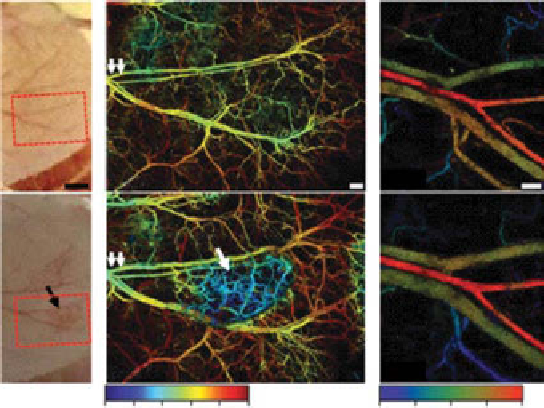Biomedical Engineering Reference
In-Depth Information
(c)
(a)
(b)
(d)
3.0
**
2.0
1.0
0.0
1.2
1.0
*
0.8
Day 0
Day 0
Day 0
0.6
2.5
*
GT
2.0
1.5
1.0
GT
0.5
Day 0
Day 7
(e)
1.0
*
Day 7
Day 7
Day 7
0.8
0.2
1
0
0.5
z
(mm)
SO
2
0.6
Extra
Intra
figure 10.5
Label-free metabolic PA quantification of Mro
2
in vivo
. (a) Photographs of
a mouse ear before and 7 days after inoculation of U87 glioblastoma cells. (b)
In vivo
PA
images of microvasculatures in the tumor region. (c)
In vivo
PA images of So
2
in the tumor
region. (d) Metabolic PA quantification of volumetric blood flow rate, oEF, and Mro
2
at
7 days postinoculation compared to 0 day. (e) Comparison of the averaged So
2
values in the
intra- and extratumoral vasculatures. (reprinted with permission from ref. [60]. © SPIE.)
*p < 0.05
**p < 0.01
10.5
exogenous contrasts for Pat
Although the aforementioned intrinsic parameters provide considerable PA con-
trasts, these contrasts deliver strong PA signals in the visible spectral range, where
the optical scattering and absorption of biological tissues are significant. This ulti-
mately prevents light penetration. Therefore, nIr light (i.e., ~650 to ~900 nm), which
can maximally penetrate in tissues due to significantly reduced optical absorption
and scattering, is widely used for deep tissue PA imaging [82]. However, not many
intrinsic contrasts are available in this spectral range. Thus, nIr absorbents have
been extensively explored to enhance the capability of PAT. The sensitivity, speci-
ficity, and contrast of PAT are dramatically improved by exogenous contrast agents.
Additionally, some optically transparent biological tissues in both visible and nIr
regions such as lymphatics and urinary bladders can be visualized with injection of
the contrast agents [83, 84]. optical absorbents including small molecules, micro-
and nanoparticles, reporter genes, and FL proteins have been successfully adapted
in PAT. organic dyes such as methylene blue (MB) [39, 40, 83] and indocyanine
green (ICg) [41, 85] have been widely used in PAT as contrast agents, but the small




















Search WWH ::

Custom Search